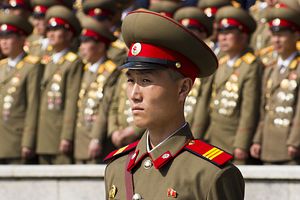It is easy to become frustrated as one reviews the inventory of seemingly failed or inadequate policy recommendations for how the United States might more effectively deal with North Korea. But frustration cannot be allowed to turn into fatalism, and important interests should not fester unattended until they metastasize into an even larger problem that will inevitably require even more dramatic, bold, and costly responses.
North Korea’s efforts to develop nuclear weapons capabilities continue unchecked and complicate both military and diplomatic options for pursuing denuclearization. Michel Wallerstein showcases a clear inventory of North Korea’s continued efforts and the limited policy options for the United States, as do a range of papers for the Johns Hopkins University SAIS U.S.-Korea Institute’s nuclear futures project.
The inventory of possible measures for dealing with North Korea at this stage fall into four main categories:
1) The squeezers, who hope that tougher sanctions will force North Korea to give up its nuclear capabilities. For instance, Sue Terry, writing for the National Bureau of Asian Research, recommends that the United States “double down on sanctions by enforcing against North Korea the kind of sanctions that brought Iran to the negotiating table.” This approach mirrors the intent of several sanctions bills under consideration in the U.S. Congress.
2) The China firsters, who anticipate that private Chinese expressions of disgust and frustration with North Korea can be integrated into China’s official policy and be leveraged to achieve a grand bargain that results in the elimination of the North Korean threat, either through Chinese acceptance of Korean unification or replacement of the Kim Jong-un regime with a North Korean leadership that respects the boundaries imposed by China’s strategic interests. For instance, Richard Haass, president of the Council on Foreign Relations, has advocated that Beijing and Washington reach strategic consensus on Korean reunification. There is a broad consensus on the need to work with China in the U.S. policy community, but there is disagreement on what could realistically be achieved with such an approach.
3) The saboteurs, who hope to take advantage of North Korea’s pursuit of provocations, nuclear tests, and human rights violations to undermine international and domestic support for the Kim regime. Harvard University’s Jieun Baek argues for a combination of covert information operations to collaborate with internal dissidents, strengthening of nongovernmental organizations that train North Korean refugees in information dissemination and business skills, and training of North Korean defectors in journalism, information technology, and social media. There is also the temptation to weaken North Korea’s legitimacy through naming and shaming regarding the country’s human rights failings as exposed by the UN Commission of Inquiry on North Korean human rights.
4) Re-engagers, who see continued dialogue with North Korea as an essential step in “probing North Korea’s intentions.” A variant of this view recognizes that in the face of the seemingly impossible dream of denuclearization, the United States should open up dialogue with North Korea on other issues where there is a chance of constructive dialogue.Doug Bandow at the Cato Institute wants the United States to withdraw and empower the South Koreans to take the lead in dealing with the North, while Adam Mount and Van Jackson support a U.S.-ROK alliance-backed “South Korea first” policy in pursuit of dialogue with North Korea.
Most analysts pursue a combination strategy that employs all four levers to bring North Korea to denuclearize. In its policy of deterrence, pressure, and dialogue, the Barack Obama administration’s approach contains these elements, but thus far, not in a combination or weight that has been sufficient to make progress. My Policy Innovation Memorandum also seeks to strengthen both sanctions and engagement, but with a twist: Why not take steps both to shape the environment so that North Korea recognizes that it must make a strategic choice and develop the benefits of such a choice with greater specificity, both through concrete studies of what North Korea can gain economically from integration and from development by the five parties in Six Party Talks (absent North Korea) of the tangible benefits that would accrue from a sincere return to the “action-for-action” approach that initially characterized the Six Party Process.
Resuming Six Party Talks without North Korea would have two important effects. It would spell out publicly the tangible benefits that would accompany denuclearization so as to stimulate a more active debate over denuclearization among Pyongyang’s elites, and it would provide a benchmark by defining a reasonable consensus among North Korea’s neighbors on the benefits that should rightfully accrue from denuclearization.
Some may argue that this proposal sounds like a last ditch strategy; others may prefer a different combination of the options outlined above. But one thing is sure: When North Korea’s nuclear weapons problem metastasizes from an important issue into an urgent issue, there will be even fewer feasible options available for consideration.
Scott A. Synder is Senior Fellow for Korea Studies and Director of the Program on U.S.-Korea Policy. This post appears courtesy of CFR.org and Forbes Asia.
































